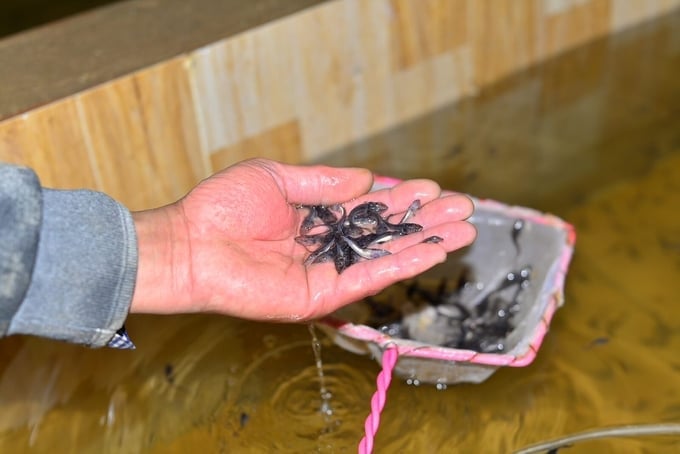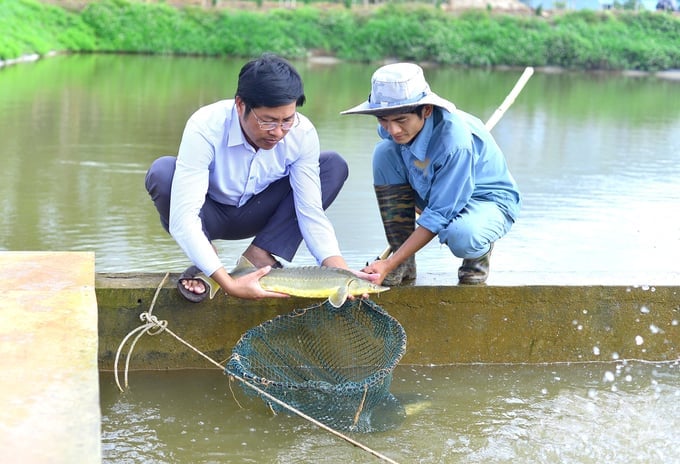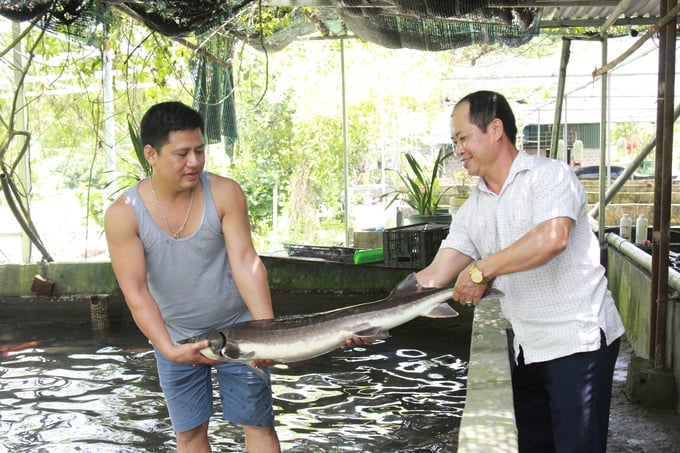November 19, 2025 | 04:15 GMT +7
November 19, 2025 | 04:15 GMT +7
Hotline: 0913.378.918
November 19, 2025 | 04:15 GMT +7
Hotline: 0913.378.918

The National Center for Freshwater Aquaculture in Central Vietnam has conducted extensive research on coldwater fish species in Lam Dong province since 2006. Photo: Phuong Chi.
Vietnam has been recognized by the United Nations Food and Agriculture Organization (FAO) as the sixth-largest producer of coldwater fish globally. Notably, Lam Dong and Lao Cai provinces have emerged as the fastest-growing and largest coldwater fish production regions, housing the country's most extensive aquaculture facilities.
The National Center for Freshwater Aquaculture in Central Vietnam has conducted extensive research on coldwater fish species in Lam Dong province since 2006.
To date, the Center has conducted research and surveys on four coldwater fish species, namely: rainbow trout, sturgeon, European whitefish, and cod (also known as Australian grouper).
Among these species, rainbow trout and sturgeon are the primary species farmed in Vietnam, with sturgeon accounting for the majority of the yield. On the other hand, European whitefish is less commonly farmed due to its slow growth rate and small size; and cod farming faces challenges in terms of seed supply.

Research on sturgeon breeding and aquaculture technologies has been widely adopted by local communities in their production process. Photo: VAN.
The Research Institute for Aquaculture III and Research Institute for Aquaculture I has conducted research on artificial sturgeon breeding technologies through various projects and initiatives, including: "Research and development of Russian and Siberian sturgeon farming in the Central Highlands"; "Development of coldwater fish species," "Improvement of technological processes and production of sturgeon breeds."
After twenty years of development, both of the research institutes have received significant support from the Ministry of Science and Technology, the Ministry of Agriculture and Rural Development, the Directorate of Fisheries, and local departments of Science and Technology in provinces with potential for coldwater fish farming.
The two research institutes have jointly implemented over 15 research projects in this field. Their results have demonstrated the practicality of key technological processes and technical advancements.
There are currently four advanced technical processes certified by the Directorate of Fisheries, and applied in mainstream production, including artificial reproductive technology for select sturgeon species; rainbow trout farming in flowing water tanks; sturgeon farming in flowing water tanks and cages on reservoirs. These fundamental advancements have contributed to the sustainable development of the coldwater fish farming industry.
With the assistance of demonstration farming models, training courses for local farmers, technical materials and instructional videos on mass media, and seminars between businesses and stakeholders, these technical advancements have been transferred, replicated, and applied in practice.
Local farmers in Lam Dong province have widely adopted two primary processes for sturgeon farming; namely, farming in flowing water tanks and farming in cages on reservoirs. Accordingly, Lam Dong currently produces nearly 2,000 tons of coldwater fish per year.
Additionally, the National Center for Freshwater Aquaculture in Central Vietnam has transferred the artificial reproductive technology to a local business for application in sturgeon farming activities under Vietnam's climate and geographical conditions. The technology requires a high level of expertise and substantial infrastructure investment. However, the business has made systematic investments and mastered the technology.

Research on breeding and farming techniques has significantly enhanced and shaped the coldwater fish farming industry in Vietnam. Photo: VAN.
Regarding coldwater fish breeding, the majority of farms with adequate infrastructure have independently cultivated seeds to support their commercial farming; and provide seeds to other small-scale farmers who lack the means to implement breeding technologies.
On the afternoon of July 10, the Ministry of Agriculture and Rural Development organized a Forum with the aim of connecting scientific, technological products in agriculture with the business community, cooperatives, and the public. Minister of Agriculture and Rural Development Le Minh Hoan, and Deputy Minister Phung Duc Tien presided over the Forum.
The Forum saw the participation of leaders from departments under the Ministry of Agriculture and Rural Development, research institutes, affiliated universities, businesses, cooperatives, and international organizations operating in the field of agriculture.
The Forum took the form of a Q&A session, directly addressing questions raised by the delegates. It featured presentations on the Ministry's policies and initiatives to promote research, innovation in science and technology, and their respective achievements. It also highlighted successful case studies of transferring scientific and technological products into production.
Vietnam Agriculture News covered this event on www.nongnghiep.vn.
Translated by Nguyen Hai Long

(VAN) Integrating agricultural extension activities with ecotourism development unlocks promising new avenues for localities boasting specific advantages in grape and apple cultivation.

(VAN) Enterprises and cooperatives accompany farmers in Tay Ninh to develop an organic seedless lime growing area, paving the way for poverty reduction.

(VAN) There were times when Pho faltered, yet his aspiration to bring the pure aroma to those who truly value clean tea kept urging him forward.

(VAN) Bich Thao Coffee Cooperative pioneered products achieving the national 5-star OCOP standard, paving the way for Son La coffee to conquer international markets.

(VAN) The Bao La bamboo-and-rattan cooperative has been producing goods integrated into value chains. As a result, its products have reached global markets.

(VAN) The training course in An Giang equips learners with emission verification methods, thus creating a basis for low-emission rice production.

(VAN) Thu Lum commune is focusing on developing medicinal plants under the forest canopy, creating sustainable livelihoods for local people, and contributing to protecting the ecological environment.